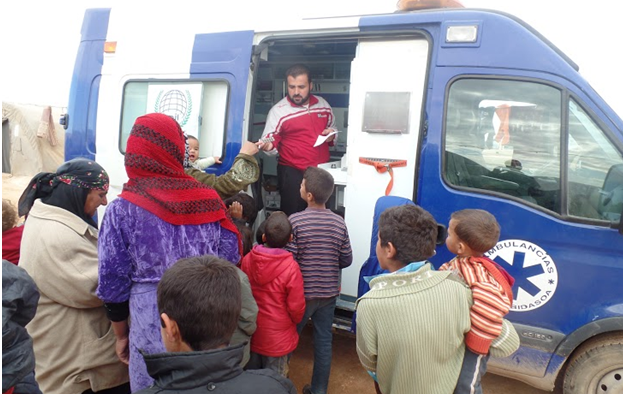PHOTO: The “ambulance clinic” distributes medicine in southern Idlib Province
Syria Direct interviews Dr. Aqba Dagheem, director of Syria for Relief and Development, about a mobile clinic in an ambulance in southern Idlib Province.
The clinic, treating an average of 100 people per day, is the source of medical care for more than 15,000 people displaced by Russian and regime attacks and living in tents.
Q: What was the impetus for this project?
The idea for the mobile clinic was to be a fast response to the needs of the new people displaced by regime attacks in the southern Aleppo countryside and the Hama countryside.
Those people were living in underserved camps far from health centers, so we launched the first project to cover these camps and meet their needs.
Most importantly, there is preparation for a larger future project to expand mobile clinics to cover internally-displaced people in other parts of Syria.
Q: How and where are patients treated?
There is an ambulance with medical personnel that is stocked with medical supplies needed for examination and treatment. The clinic is staffed by a general practitioner, two nurses, and two people to distribute medicine.
Every day the vehicle goes to a different camp at a set time to provide medical services to the displaced [in six locations]. They are treated inside the ambulance if need be, but most of the time in one of the camp’s tents. The medical personnel also visit the sick in their own tents if moving them is difficult.
Q: What kind of cases do you treat?
We’ve noticed many infectious diseases due to people intermingling. There are respiratory ailments and skin diseases such as scabies and lice, as well as follow-ups for chronic illnesses.
Q: Are the medicines needed for treatment available?
Yes, they are available [from Syria for Relief and Development]. We try to secure as much as possible, but there are sometimes shortages due to the high pressure from the patients and the need to provide them with medication due to their distance from medical clinics.
There is a lot of pressure on the clinic, which treats around 100 people a day. There is huge need and wide geographic areas. That is why we are planning to launch two additional, specialized clinics.

